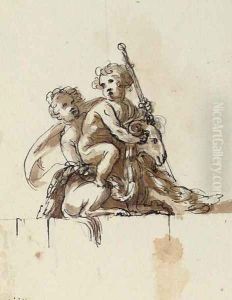Pieter Antonie Von Verschaffelt Paintings
Pieter Antonie (also Pietro or Peter) von Verschaffelt was a noted Flemish sculptor and architect born in Ghent, Belgium, in 1710. His work is a reflection of the late Baroque and early Neoclassical styles, marking a transitional period in European art history. Verschaffelt's education in art began in his hometown, but his talent soon necessitated travel and study abroad, leading him to Rome. It was in Rome where he truly flourished as an artist, absorbing the rich classical heritage of the city, which would profoundly influence his later works.
Verschaffelt's reputation grew swiftly, and his skill in sculpting figures and groups in a dynamic and expressive manner gained him significant attention. Among his most celebrated works is the replacement statue of the Archangel Michael atop Castel Sant'Angelo in Rome, completed in 1753. This particular work showcases his ability to blend strength and grace, capturing the Baroque spirit while also hinting at the emerging Neoclassical style.
In addition to his sculptural works, Verschaffelt was also involved in architectural projects. In the latter part of his career, he was appointed as the court sculptor and architect in Mannheim, Germany, by the Elector Palatine, Carl Theodor. There, he was responsible for several important commissions, including the design of the Mannheim Palace gardens and the construction of the famous Schwetzingen Palace's mosque, one of the earliest examples of Moorish Revival architecture in Europe. His contributions to the architectural landscape of Mannheim and beyond were significant, blending aesthetic appeal with innovative design.
Verschaffelt's influence extended beyond his immediate works. He was a mentor to many young artists and his approach to sculpture and architecture left a lasting imprint on the transition towards Neoclassicism. Despite the changing tastes and styles of the time, his work remained respected for its craftsmanship and artistic integrity. Pieter Antonie von Verschaffelt passed away in Mannheim in 1793, leaving behind a legacy that continues to be celebrated for its contribution to the evolution of European art and architecture.
